Whether you’re ready to get started or would like to know more, we’re here to help.
By Feann Torr, carsales.com.au
Nissan is driving in a different direction towards the horizon of low emission mobility. The Japanese brand has received critical acclaim for its unique solution for petrol-electric hybrids, called e-POWER, since it was first introduced on the latest generation X-TRAIL mid-sized SUV.
And now it has made the technology, which flips the relationship between petrol and electric motors, more accessible and more affordable by transferring it to the smaller QASHQAI SUV.
In most hybrid vehicles, the electric motor simply supports the petrol engine by providing additional power when required to reduce fuel consumption. With e-POWER, the petrol engine acts as an on-board generator to provide power to the battery pack, essentially making it an electric vehicle.
Now available in the QASHQAI, it is a compelling option for eco-conscious buyers willing to pay a premium. Let’s explain why.
How much does the Nissan QASHQAI e-POWER cost?
The 2024 Nissan QASHQAI e-POWER is exclusively available in the range-topping Ti trim and is priced from $51,590 plus on-road costs, which is quite expensive for a small SUV from a mainstream brand.
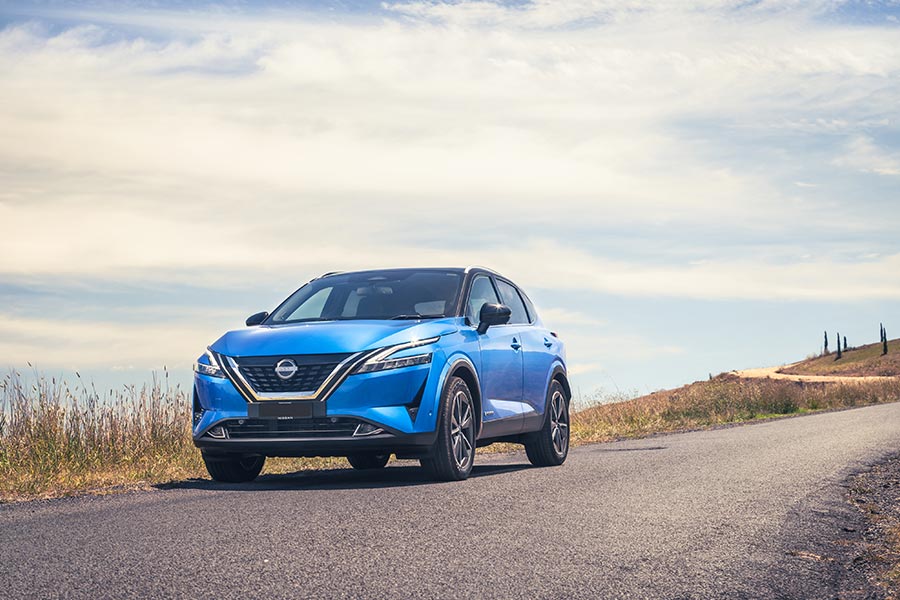
That equates to a $4200 premium for the powertrain alone over the equivalent petrol-only flagship version, as it comes equipped with the same, admittedly extensive, list of standard equipment that includes a massive panoramic glass sunroof, three digital screens, big 19-inch alloy wheels, leather trim and more.
Nissan is expected to release cheaper versions of the QASHQAI e-POWER ‘electric drive’ hybrid in due course, but for now rivals like the Hyundai Kona Hybrid and Toyota Corolla Cross Hybrid start much lower, from around $36,000, and have more model diversity.
Even the Honda HR-V hybrid is cheaper than the Nissan at $47,000 drive-away, while the plug-in hybrid Mitsubishi Eclipse Cross PHEV starts from $47,290 plus ORCs.
Aftersales coverage includes a fairly standard five-year warranty and an above-average five-year roadside assistance program.
Capped-price servicing across five years is pegged at $2007 if you pre-pay at the beginning or $2230 if you pay annually or every 10,000km, whichever comes first.
That works out to around $400 per year (pre-paid) on average, and like the warranty, pre-paid service plans are transferrable if you on-sell the vehicle.
Notably, the e-POWER model is considerably cheaper to service than the petrol-only QASHQAI, which costs around $100 more per 12-month/10,000km service.
What equipment comes with the Nissan QASHQAI e-POWER?
The QASHQAI is Nissan’s most popular model in Europe, and it comes as no surprise that this UK-sourced flagship is crammed with premium equipment given the competition it faces from more fashionable brands like Citroen, Peugeot, Skoda, and Volkswagen.
To that end, the list of standard equipment reads more like a genuine luxury vehicle than a mainstream city SUV, with items including a 10-speaker Bose stereo with subwoofer, quilted leather seat upholstery with heated and massaging front seats (and memory settings for the driver’s position), a heated steering wheel and a large panoramic glass roof that makes the cabin feel bigger and brighter.
Ambient LED cabin lighting is also part of the Ti package, as is a wireless phone charger, a trio of large digital screens including embedded satellite navigation on the central screen, dual-zone automatic climate control, a powered tailgate with gesture (foot kick) control and 19-inch alloy wheels.
What technology does the Nissan QASHQAI e-POWER feature?
Aside from the luxurious appearance of its fancy seats, the big drawcard as you step into the 2024 Nissan QASHQAI e-POWER Ti are the twin 12.3-inch digital screens.
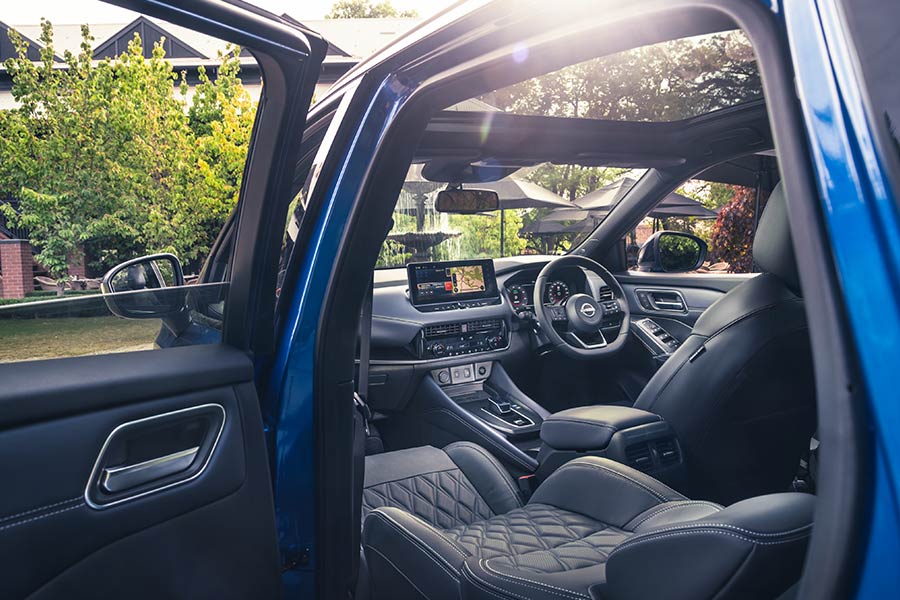
The central touchscreen has clear, sharp visuals and features wired and wireless Apple CarPlay but only wired Android Auto.
Embedded sat-nav is a nice touch, especially when you’re out of mobile phone range. And, while the menu system is intuitive, nicely arranged and delivers prompt touch response, the operating system lacks the depth of some rival small SUVs.
Despite digging around through the menu structure, I couldn’t find an energy flow menu to disseminate the interplay between battery, engine, generator, and inverter on the main screen. However, there is a graphic on the 12.3-inch digital instrument cluster that is somewhat basic but does the job.
The digital instrument display is generally very good, with plenty of driving data along with adjustable visual elements and themes.
The third and final screen, a 10.8-inch colour head-up display (beamed onto the windscreen directly in your line of sight), is very impressive with clear, vibrant visuals showing the current speed limit, vehicle speed, navigation directions and so on.
A large wireless phone charger is joined by twin USB ports – A and C – located in the centre console, but the NissanConnect remote services available overseas are missing here and there’s no timeline for its introduction, which is a shame.
What is the Nissan QASHQAI e-POWER like inside?
The QASHQAI’s cabin presents well with plenty of surprising and delightful touches you wouldn’t expect from a mainstream brand.
The quilted leather seats are beautiful to look at and both supportive and comfortable to sit in for front seat occupants and match the tactility of the rest of the cabin’s materials and overall build quality.
The large 12.3-inch touchscreen dominates the centre of the dash but doesn’t feel out of place against the similar-sized digital instrument cluster and super-useful 10.8-inch head-up display. It’s a nice match of tradition and technology.
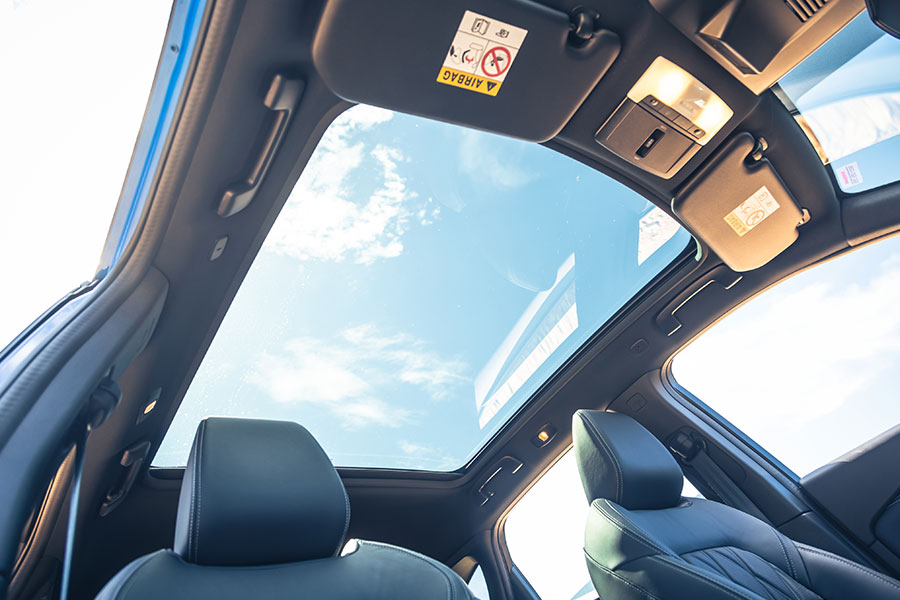
There’s also a very capable 10-speaker Bose stereo that blasts crisp and clear audio, a large wireless phone charger, two USB ports up front and a gorgeous panoramic glass roof that soaks the cabin with light to make it feel more spacious.
Rear-seat occupants are treated to a respectable amount of space for such a small SUV, as well as USB-A and USB-C ports, reading lights, air vents and a fold-out arm rest, while twin ISOFIX and triple top-tether child seat anchorages are there to secure little-uns.
And if you do have small children, the ultra-wide-opening doors (similar to the X-TRAIL) are a godsend; they make loading tiny people in and out of the vehicle a whole lot easier.
The power-operated tailgate can be opened hands-free by foot, laptop or metal bottle and reveals a versatile cargo area with hidden underfloor compartments and handy dividers that stop things rolling around.
Boot space is the same as the regular QASHQAI, which is impressive, although there’s no space-saver spare tyre now, replaced with a puncture repair kit.
How safe is the Nissan QASHQAI e-POWER?
Like all models in the range, the 2024 Nissan QASHQAI e-POWER Ti scores a maximum five-star ANCAP safety rating based on testing carried out in 2022.
On top of a strong safety cell and seven airbags, the e-POWER Ti comes with plenty of advanced driver assistance systems under Nissan’s ProPilot semi-autonomous driving suite, including adaptive cruise control, lane keep assist, blind spot detection/intervention and real-time traffic sign recognition that provides live speed-limit updates on the digital dashboard and head-up display.
Rear cross traffic alert, intelligent forward collision warning, driver attention alert and autonomous emergency braking (AEB) with junction assist and vehicle, cyclist and pedestrian detection are also part of the package, as are front and rear parking sensors.
There’s a 360-degree surround-view camera system and even auto parking if you want to let the QASHQAI slot itself into a car space instead.
A tyre pressure monitoring system and more exterior LED lights than a rave party are included, the latter comprising daytime running lights, automatic headlights with auto levelling and adaptive driving beams, fog lights and taillights.
What powers the Nissan QASHQAI e-POWER?
It’s under the skin where things get really interesting with the Nissan QASHQAI e-POWER.
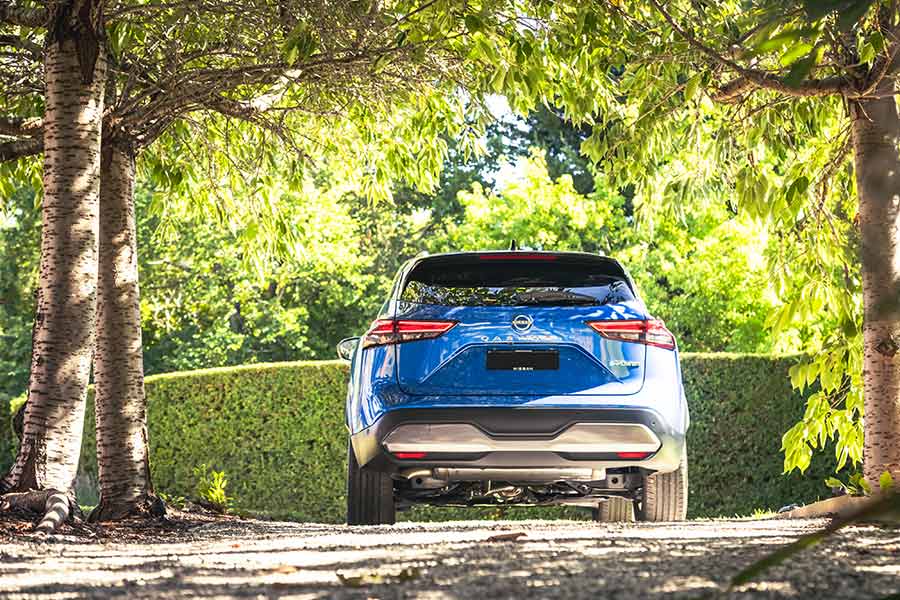
Where regular models have a 1.3-litre turbo-petrol four-cylinder engine that produces 110kW/250Nm and drives the front wheels through a continuously variable automatic transmission (which is all very conventional), the e-POWER has a slightly larger 1.5-litre three-cylinder turbo-petrol engine that isn’t connected to a transmission or the driving wheels at all.
Instead, it acts as a generator for an inverter that converts the power to electricity for the 2.1kWh lithium-ion battery pack, which then provides energy for the e-motor that drives the front wheels.
It might sound complicated, but the system is rather simple and creates a vehicle that has all the driving characteristics of a proper electric car with the driving range and quick refuelling properties of a conventional vehicle.
Officially, the petrol engine produces 116kW of power, but because the e-motor provides the motive power the QASHQAI e-POWER offers 140kW of power and 330Nm of torque, which makes it one of the most powerful vehicles in its class.
Even when the engine is purring away to charge the battery or feed the invertor (or both) it’s reasonably quiet thanks to the four-stroke engine’s variable compression set-up, which ranges between 8:1 to 14:1 depending on demand and in turn keeps revs relatively low while maximising torque.
Active sound cancelling works just like the popular headphones (using the Bose subwoofer to generate a counter-frequency in this case) and the cabin is surprisingly hushed.
Another benefit of this range-extending set-up is the removal of Nissan’s CVT (continuously variable transmission). Instead, a one-speed automatic reduction drive is used here, ensuring no mechanical interruption to acceleration, which is seamless.
The e-POWER system features regenerative braking technology that delivers wasted energy under deceleration back into the battery pack to further reduce fuel consumption and improve driving range. But it does not require owners to plug-in to recharge.
Instead, just fill-up the 55-litre fuel tank at a service station as you would a normal car, and the QASHQAI e-POWER offers a theoretical driving range of more than 1000km on a full tank.
How fuel efficient is the Nissan QASHQAI e-POWER?
Can you hear that? It’s a penny dropping. So, is the $4200 premium for the 2024 Nissan QASHQAI e-POWER Ti system worth it?
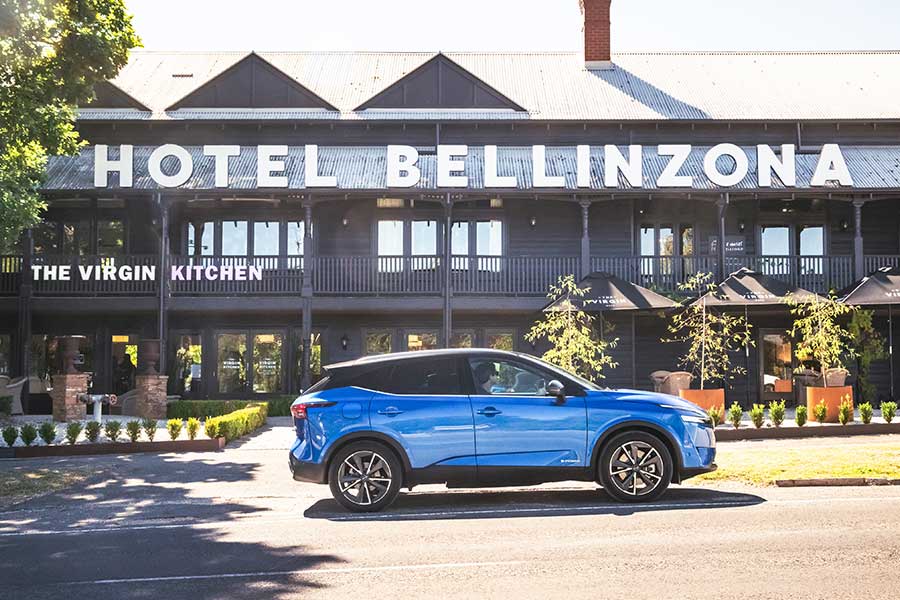
Nissan reckons it’s around 15 per cent more efficient than the petrol-only QASHQAI, consuming a claimed average of 5.2L/100km on the official combined-cycle test versus the conventional SUV’s 6.1L/100km.
Across the launch drive, we finished with a 5.5L/100km scorecard, which isn’t too shabby considering it is carrying an extra 200kg of mass… and especially when we averaged 8.1L/100km in the regular QASHQAI last year.
There’s a one-pedal driving system that is probably the most effective way to drive economically, with strong recuperative braking occurring when you lift off the throttle pedal.
What is the Nissan QASHQAI e-POWER like to drive?
During the launch we spent about 20 per cent of our vehicle evaluation time in urban areas while the rest was on 80km/h arterial roads, 100km/h freeways, and country roads.
And for the most part, the 2024 Nissan QASHQAI e-POWER Ti was extremely pleasant to drive.
It stands to reason the QASHQAI e-POWER does its best work at slower speeds and in stop-start scenarios, but by the end of the first stint, a 300km drive (with a high average speed of 71km/h), the figure settled at 5.5L/100km.
Driven sedately (which was our modus operandi for the most part), the QASHQAI e-POWER is quiet, smooth, and refined. Conversation flows easily in the hushed cabin, the massaging seats with three modes and different intensity settings adding a touch of luxury.
Push the throttle and the engine’s presence emerges with a hushed tone in the background. It’s unusual to listen to its static engine speed rather than hearing the revs rise in direct relationship to speed. But, once the novelty disappears, so does the engine’s faint intrusion. You’d hardly know it was there.
At full throttle, acceleration is swift (0-100km/h in 7.9 seconds is the claim), and despite the extra mass it carries around via all the hybrid gubbins, the QASHQAI e-POWER has a lot more spring in its step compared to the regular petrol models.
Its ability to soak up road imperfections is more than acceptable, riding across minor ruptures and gashes in the surface with relative comfort. That said, it doesn’t feel quite as nimble tracking through corners as the petrol-only QASHQAI.
According to Nissan’s European engineering corps, almost every element of chassis (dampers, springs, anti-roll bars, bushes) has been tuned to accommodate the extra 200kg of mass, but it doesn’t quite have the confidence of the regular car, with more body roll and less grip when you dial up the cornering tempo.
Can the Nissan QASHQAI e-POWER go off-road?
There aren’t many cars in the QASHQAI’s class that you could consider driving any further off the beaten path than a dirt road or gravel driveway.
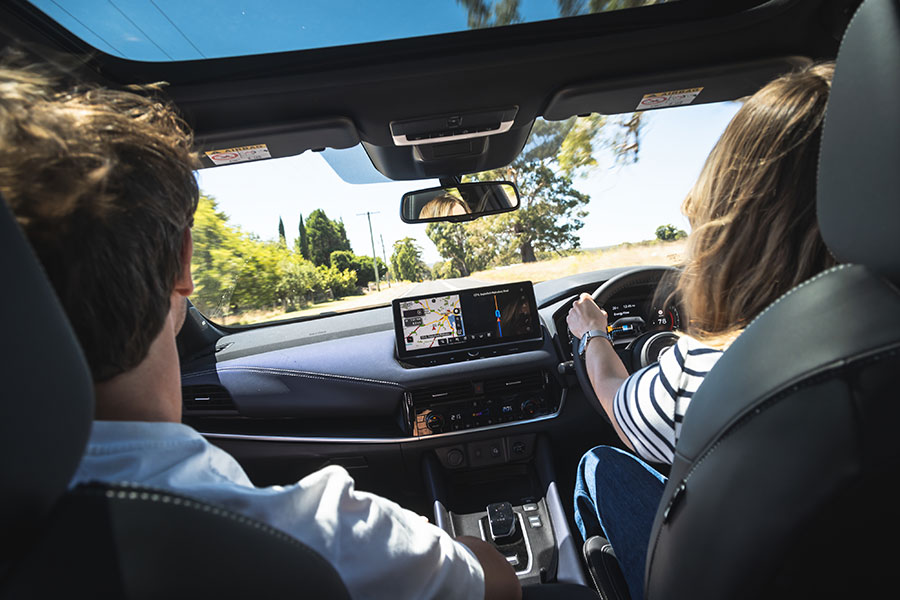
Like many of its rivals, the QASHQAI e-POWER is only front-wheel drive so there’s the first sign it’s not built for much more than the urban jungle. Plus, it rides on low-profile 19-inch tyres that aren’t much chop in the rough stuff and more prone to punctures than proper off-road rubber.
It does have three drive modes – Eco, Normal and Sport – that alter the throttle, regen and traction control to create faintly different driving characteristic. But there’s nothing specific for off-road. So, no… the QASHQAI e-POWER isn’t really suited to much more than light-duty dirt road driving.
Should I buy a Nissan QASHQAI e-POWER?
On first impression, there’s a lot to like about the 2024 Nissan QASHQAI e-POWER.
The concept of a range-extending petrol-powered hybrid that never needs to be plugged in and has no range anxiety-inducing quirks is appealing.
It is smooth and quiet to drive – just like an EV – has an upmarket ambience and we’re happy with the real-world fuel consumption figure of 5.5L/100km achieved on launch; we could certainly get it lower with more urban driving.
But is it $4200 better than the standard Nissan QASHQAI Ti, which has the same equipment?
It’s hard to say definitively one way or the other after driving it for a couple of days because the circa-15 per cent fuel saving would take a long time to recoup.
Then again, it offers a perfect stop-gap solution for those afraid to commit to a fully electric vehicle, offering all the good bits of an EV in terms of how it drives without compromising driving range and the convenience of quick re-fills.
2024 Nissan QASHQAI e-POWER Ti at a glance:
Editor’s Rating: 7.5/10
| Price: $51,590 (plus on-road costs) |
Transmission: Single-speed reduction gear |
| Available: Now |
Fuel: 5.2L/100km (ADR Combined) |
| Powertrain: 1.5-litre three-cylinder turbo petrol-electric |
CO2: 117g/km (ADR Combined) |
| Output: 116kW (electric motor: 140kW/330Nm) |
Safety Rating: Five-star (ANCAP 2022) |
| Combined output: 140kW/330Nm |
Disclaimer: Images supplied by Nissan Australia.
This article was prepared by an independent author. The information contained in this article represents the views and opinions of the original author, and is based on research carried out by the original author. The appearance of the article on Maxxia's website does not constitute an endorsement of its content by Maxxia in any way. The article has been made available for informational purposes only and should not be taken as advice. While all reasonable care has been taken to ensure that the statements made by the original author in the article are fair and accurate, Maxxia does not guarantee or warrant the accuracy or completeness of this information and will not be liable for, or in connection with, any loss or damage suffered as a result of any inaccuracies, errors or omissions or your reliance on this information. You should independently research and verify information before making any decision in respect of a vehicle.

